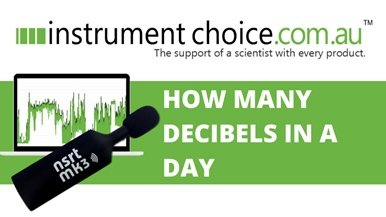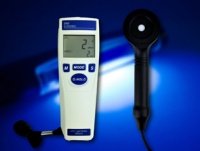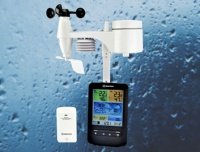Instrument Choice Experiment: How Many Decibels in a Day

Are the typical sound levels in your life injuring your hearing?
In this experiment, we carry around a sound level data logger to discover what sound levels we encounter day-to-day to determine whether they are hazardous.
The science behind the experiment
Why measure sound levels?
When sound volume reaches harmful levels, it can impact the inner ear's functioning and result in temporary hearing loss. With repeated exposure to dangerous noise, the ear will have a compromised ability to recover. Permanent hearing impairment or loss may result. Somewhere between 28–32% of the Australian workforce are employed in environments subjected to harmful noise - so monitoring these levels is a vital task!
How is sound measured?
A decibel is a relative unit of measurement for gauging the intensity of sound. The decibel scale (dB) is logarithmic, meaning for every 10 dB increase, there is a 10-times increase in sound intensity. Check out Image 1 (below) for examples of decibel levels associated with commonly occurring sounds.
Figure 1 Examples of decibel levels associates with common sounds
So, how much sound is too much?
The safety standards and limits for noise management are set out in the Work Health and Safety (Managing Noise and Preventing Hearing Loss at Work) Code of Practice 2015. Determining breaches of the safety limits for noise depends on two things;
- Detected sound levels; and
- Duration of exposure.
Table 1 (below) provides examples of the noise levels a person can experience before exceeding the standard (LAeq, 8h = 85 dB(A).
Noise level dB(A) |
Exposure time before standard exceedance |
|
80 |
16 hours |
|
85 |
8 hours |
|
88 |
4 hours |
|
91 |
2 hours |
|
94 |
1 hour |
|
100 |
15 minutes |
|
103 |
7.5 minutes |
|
109 |
1.9 minutes |
|
115 |
28.8 seconds |
|
121 |
7.2 seconds |
|
127 |
1.8 seconds |
|
130 |
0.9 seconds |
Table 1 The length of time a person without hearing protection can experience a level of noise before the standard (LAeq, 8h = 85 dB(A)) is exceeded (Source: Work Health and Safety (Managing Noise and Preventing Hearing Loss at Work) Code of Practice 2015)
Essentially, a worker exposed to 85 dB(A) for eight hours receives the same noise energy as someone exposed to 88 dB(A) for four hours. If you were exposed to 88 dB(A) for four hours and spent the remainder of the day in a quiet office environment, you likely would not exceed the standard. But if you were to continue to spend more than four hours working in the same noise-producing environment, it would be dangerous.
|
Warning: Peak noise levels above 140dB(C) can cause almost instantaneous hearing damage! |
Experiment description & method
Firstly, we programmed the sound level logger to commence recording at 4:25am and continued logging at 1-second intervals until 12:30 pm. Our Instrument Choice Scientist went about their normal daily activities with the sound level logger positioned at arm's length. Every 30 minutes, they made a note of their activities.
After completing the data recording, results from the sound level logger were downloaded, then matched with our scientist’s activity record. We then assessed the average sound level.
Next, we interrogated collected data to examine the sound levels of selected tasks in the following environments:
- Gym,
- Walking the dogs,
- Getting ready for work,
- Driving to work, and;
- Work.
We considered the maximum sound level causes and determined whether the noise our scientist experienced exceeded the standard.
Metrics
For our experiment, we recorded results using two sound exposure metrics, namely:
- Equivalent Continuous Sound Level (Leq): The Equivalent Continuous Sound Level (Leq) represents the total sound exposure over an amount of time, i.e. the average.
- Maximum Sound Level (Lmax): This is the maximum noise level during a measurement or noise event.
Materials used
- Wireless Sound Level Meter Data Logger (IC-NSRTW_mk3)
- Computer
Results
The maximum recorded sound levels for each activity and their cause
The L-eq for the recording period of 4:25-12:30 was 69.5dB (calculated by the Instrument Manager software).
See table 2 (below) for the Lmax and 8-hour Leq corresponding to each of the five activity categories.
Activity |
L-eq |
L-max |
L-max Cause |
|
Gym |
76.9 |
88.7354 |
Loud Music |
|
Walking the Dogs |
63.8 |
96.5354 |
Garbage truck |
|
Getting ready for work |
83.1 |
92.3354 |
Hair Dryer |
|
Driving |
72.4 |
90.2354 |
Loud Radio |
|
Work |
54.8 |
95.6354 |
Passing truck when walking into the office |
Table 2 Various daily activities, the recorded L-eq, L-max and the L-max cause
Were the daily noise levels considered dangerous?
We can report some noteworthy Lmax dB levels were recorded during the experiment. See figure 2 (below) for our day in decibels.
Figure 2 Sound level recorded and 1 second intervals by the data logger from 4:25am to 12:30pm
L-Max: The maximum recorded dB level for the day was 96.5. This was from a passing garbage truck during a walk.
Leq: Interestingly, the highest recorded Leq occurred while getting ready, where we recorded an L-eq of 83.1dB for the 7 minutes of hair dryer use. If this exposure were to continue for an extended period, we would be dangerously close to the safe 8-hour exposure limit and be at risk of hearing damage.
However, after remaining in mostly quiet environments while at work, our L-eq for the 8 hours was 69.5, which is well under the 85dB exposure limit.
Conclusion
Although our volunteer experienced some surprising sound levels, there was no exceedance of 85dB over to the 8-hour Leq standard during the experiment.
Want more information on sound level meters? Speak with an Instrument Choice Scientist! We're here to help! Call 1300 737 871 or email [email protected].
Further articles about Sound Level Meters
Also interesting
Instrument Choice regularly reviews new and popular products, so when searching for the perfect scientific instrument for your application, you can make more informed decisions.
This review assesses the UV Light Meter (Product Code: IC-850010). This review sheds light on the IC-850010’s impressive features, specifications and provides some examples of use.
Get your comprehensive scientists’ review of the UV Light Meter UVC IC-850010 here

Instrument Choice Scientists often get asked how to set up some of our most popular products. This edition demonstrates how to commission your IC-XC0436 Wireless Digital Weather Station – an outstanding device with advanced features, WiFi connectivity, straightforward operation and accessible price.


